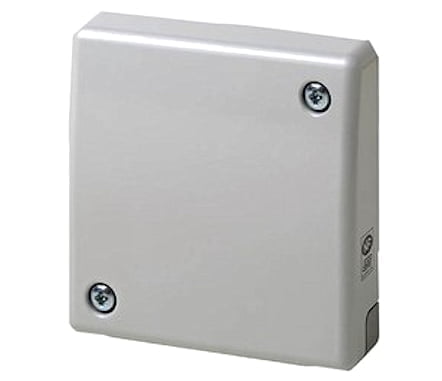Vibration sensors are designed to detect low frequency energy or vibrations caused in the aftermath of heavy impacts that occur during forceful attacks on walls, ceilings, floors or other barriers, on which there have been installed.
Because of their nature, vibration sensor transducers need to be installed on robust structures – if they’re installed on lightweight walls environmental vibrations will cause false alarms and may lead to these sensors being disconnected. Masonry walls are ideal sites for low frequency vibration sensor installations with the signal processor located nearby.
The way these sensors operate is that when a hammer or other heavy object strikes a wall, there’s an initial high frequency vibration that rapidly attenuates to low frequencies, and these lower frequencies can travel long distances through walls where they can be detected by transducers. Should a signal exceed a set electrical threshold (or move a seismic mass), then an NC/NO contact will be activated, or a circuit will be opened by a shifting mass, which will be actioned as an alarm event by the device.
A quality vibration sensor will have a signal processor, allowing vibration patterns to be analyzed assess whether they meet alarm event criteria and thresholds. Old analogue processors worked by averaging ambient conditions to shift thresholds, though this can impact on sensitivity, especially when ambient vibrations cease. Digital signal process adjusts thresholds continuously to maintain sensitivity. Manufacturers claim that DSP ‘knows’ that a disturbance is a knock on the door, or a trucking passing by, etc, but some developers argue DSP is not quite so discerning as that.
How Do Vibration Sensors Work
Transducers may be piezoelectric, which convert mechanical energy into electrical signals in a way that’s commensurate with the mechanical energy they detect – the stronger the force, the larger the signal generated. It’s this signal that’s amplified and transmitted to a signal processor via a shielded cable to protect the circuit from external interference.
When it comes to sensitivity, a typical piezoelectric vibration sensor will have an adjustable pulse count same as a PIR that’s used by the installer during installation to try to tune out projected environmental disturbances. It goes without saying that this tuning process is organic. Pulse counter count pulses of a specific magnitude before they allow the electrical signal to pass through the circuit to activate an alarm condition.
Meanwhile mechanical transducers have a seismic mass integrated into them, which makes an electrical connection between switch contacts when impacted upon by vibration. In a way, mechanical transducers are accelerometers – the seismic mass is a metal weight that responds to force applied to the transducer by accelerating out of its position. If the force of an impact on the barrier is sufficient to move the seismic mass far enough, then a contact the mass keeps closed is opened, generating an alarm event. Depending on the sensor’s seismic mass, size and spacing between electrical contacts, the overall system is able to differentiate between environmental impacts, and attempts at forced entry.
Spring-loaded switches rely on the force of the spring to close the contacts while unrestricted switches rely on gravity and this difference impacts on installations. Spring-loaded switches can be mounted in any way required on walls, or ceilings, or floors. During installation, installers tweak an adjustment screw to tweak spring tension, which adjusts sensitivity. Comparatively, unrestricted seismic mass transducers need to be mounted vertically so gravity can return the mass to the electrical contact after it’s been disturbed.
Typically, vibration transducers are installed 3-4 metres apart on a wall to be protected. They need to be very securely fastened to the surface, they’re protecting, and should be supported by tamper switches. The key issue with installing vibration sensors, is making sure they are not mounted on walls, which experience vibrations caused by machinery, traffic or plant equipment. Pulse count is important in applications where there will be an occasional impact caused by the closure of a heavy door, or bump of a heavy vehicle over a speed bump, etc.
Something to bear in mind when thinking about using vibration sensors is that piezoelectric vibration sensors do allow greater flexibility in tweaking sensitivity and alarm event thresholds to ensure false alarms are kept to a minimum. The sensitivity of seismic mass devices is less exacting – these devices are best used on heavy barriers with low levels of environmental vibration. Finally, vibration sensors are often designated 24-hour sensors because they are not impacted on by foot traffic. Provision will need to be made for them to continue protecting barriers regardless of whether alarm panels or alarm areas are deactivated.
There’s more information about vibration sensors here or you can read more SEN news here.
“How Do Vibration Sensors Work?”











